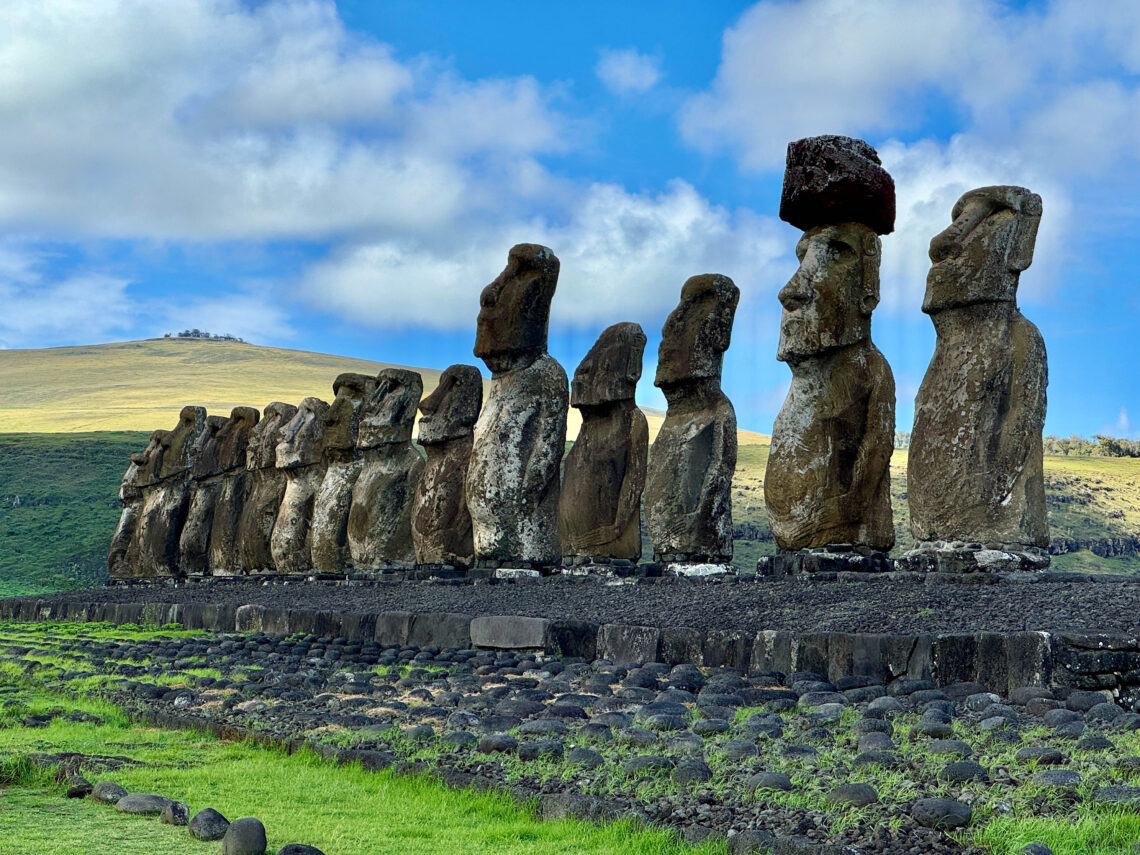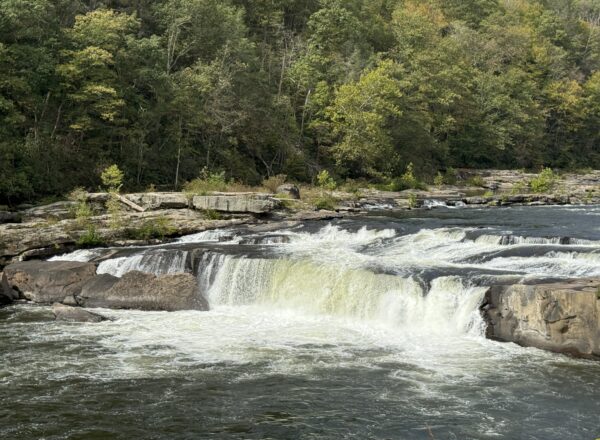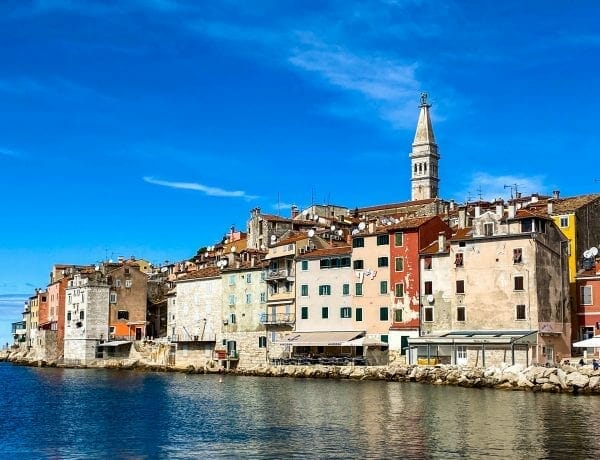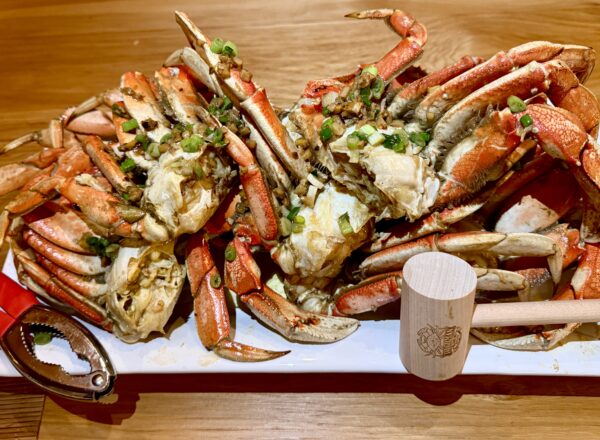“The Moai of Easter Island stand as silent witnesses to the passage of time, reminding us to be mindful of the moments we have.”
Wanderers Compass Travel Blog
- Follow Your Heart
- The Journey: Getting to the Edge of the World
- Map of Easter Island/Rapa Nui
- Before You Fly: Entry Rules for Easter Island
- Meeting Roberto: The Island’s Storyteller and Soul
- The History of Rapa Nui: A People Who Endured
- The Moai: Guardians of the Ancestors
- The Faces of the Moai
- The “Easter” in Easter Island
- Unmissable Sites: Where History Meets Horizon
- Rapa Nui National Park: Protecting a Living Heritage
- So Much More to Offer than the Moai
- A Taste of Rapa Nui: Food That Surprised Us
- How Much Does it Cost to Visit Easter Island?
- When Is the Best Time to Visit Easter Island?
- Where to Stay on Easter Island
- A Tip on Renting Cars
- Final Reflections: A Place That Lingers
- Easter Island/Rapa Nui Photo Gallery
- Our Top Recommended Travel Products
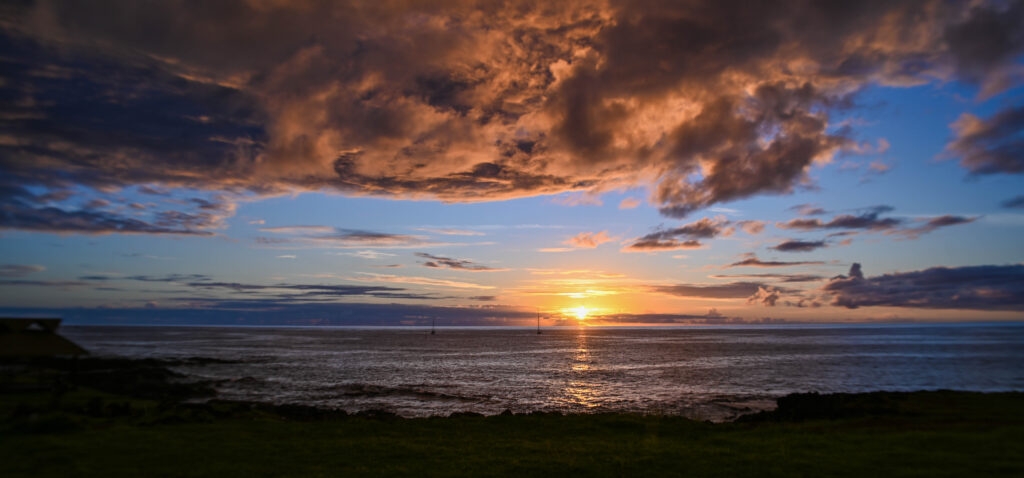
When your plane touches down on Easter Island, Rapa Nui, as the locals call it, you feel it immediately: this is no ordinary destination. At just 63 square miles and resting more than 2,200 miles off the Chilean coast, it is one of the most remote inhabited places on the planet. We spent five nights here in April for Ryan’s 40th birthday, and it became one of the most unforgettable journeys of our lives.
Ryan had dreamed of this trip since childhood. The mysterious moai statues, massive stone figures with solemn faces, had fascinated him for decades. But what we discovered was that Rapa Nui is so much more than the moai. It’s a story of survival, resilience, and cultural pride written across volcanic cliffs, windswept plains, and a people who refuse to let their history fade.
Follow Your Heart
When we told friends we were spending five days on Rapa Nui, some asked, “Isn’t that a lot of time just to look at statues?” The moai alone could fill every day with wonder; they appear in so many striking settings, but the island offers so much more. Their doubts gave us pause for only a moment, and we’re glad we trusted our hearts.
And five nights? It barely scratched the surface.
A Special Friend and Lesson Learned
This trip felt extra special because we shared it with Ryan’s longtime friend, Brandy. She brought a spark of fun and carefree energy to our travels, but she also taught us an unexpected lesson in resilience. Her luggage never made it to the island, leaving her with only what she wore on the plane, clothes, and shoes, far from ideal for Easter Island’s heat and rugged terrain. Replacements were hard to find on such a small island, and even when she managed to track down shoes, none fit quite right. Yet Brandy never let it spoil her trip. She laughed, adapted, and showed us the power of staying in the moment instead of stressing over what we can’t control. Through her, we were reminded that some of the best travel memories often come from the challenges we face.
The Journey: Getting to the Edge of the World
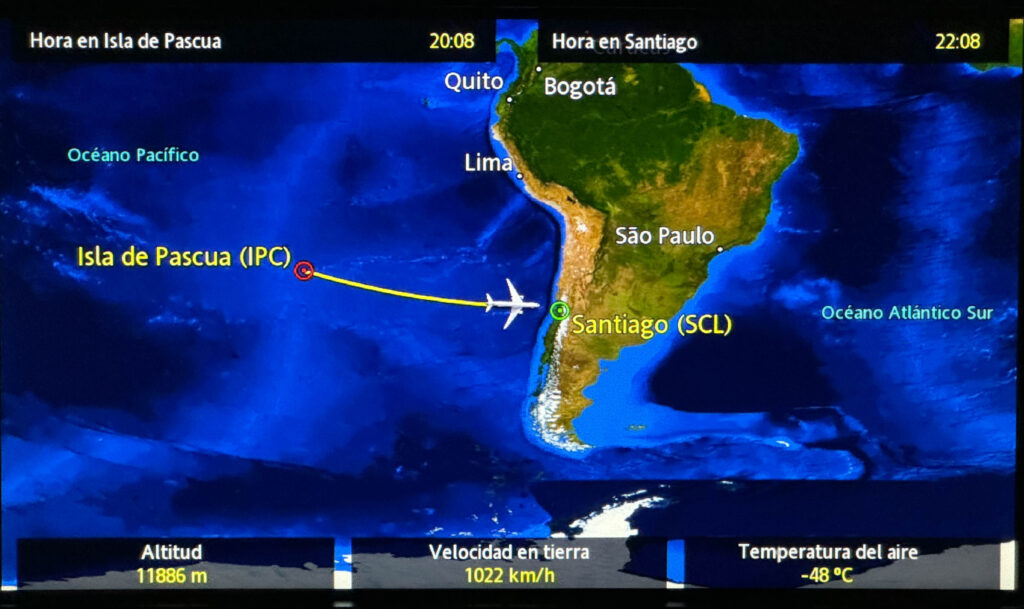
Reaching Rapa Nui feels like embarking on a pilgrimage. There’s just one daily flight from Santiago with LATAM Airlines, and preparation is everything.
The only way to reach the island is by air, and flights are limited. We flew with LATAM Airlines, the sole carrier serving Rapa Nui, which operates a single daily flight from Santiago, Chile. The journey takes about five and a half hours, and when the plane finally dips low over the island, the sight of volcanic cliffs and endless ocean makes every mile worth it. There’s something about stepping off the aircraft onto the tarmac at Mataveri International Airport, the world’s most remote commercial airport, that makes you feel like you’ve arrived somewhere extraordinary. We were even greeted with a lei being placed around our necks, which was such a sweet welcome.
We arrived in Santiago two nights before our flight, and it is a fun city to explore. In the end, we were relieved when Brandy’s luggage went missing while she was scheduled to fly straight through, and then it took its own detour. Actually, several detours. It landed in Bogota twice before she finally got it back in Santiago after we left the island.
Map of Easter Island/Rapa Nui
Before You Fly: Entry Rules for Easter Island
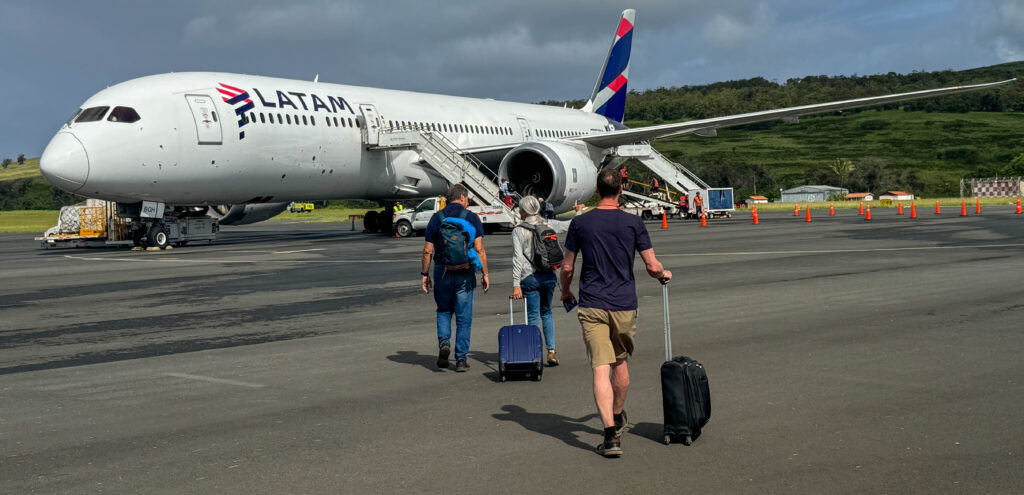
Traveling to Easter Island isn’t just about flights; it begins with documentation. Before boarding your flight from Santiago, you’ll need to complete the Single Entry Form (FUI) online (from up to 21 days before your trip), and you must carry a round-trip ticket for a stay of up to 30 days. You’ll also be required to provide proof of lodging a reservation at an accommodation registered with Chile’s tourism authority, SERNATUR, or an official invitation if staying with a local host. Authorities enforce this rigorously: you will not be able to board without meeting these requirements, period!
Meeting Roberto: The Island’s Storyteller and Soul



Exploring on our own offered freedom, but hiring Roberto Teao, a native Rapa Nui guide, gave us something far richer. From the moment we met, he radiated a grounding calm and deep warmth that set the tone for our trip. More than just a guide, Roberto was a storyteller. He invited us into the heart of Rapa Nui, offering historical facts and a living narrative that brought the island to life. And beyond the stories, having a guide like Roberto wasn’t optional; it was essential. Much of the island is part of Rapa Nui National Park, and guides are required to accompany visitors to the most significant sites. Without one, you don’t get in.
He spoke of how the Rapa Nui people have worked with the land and sea to survive and thrive, weaving stories of everyday life with the island’s spiritual traditions. And his ukulele, an eight-string, hand-carved instrument, added a layer of magic. As he played, the soft hum blended with the breeze, and it felt as though the island itself leaned in to listen. On several visits to sacred sites, his melodies echoed across stone and sky, making time feel suspended.
On our final day with him, we asked Roberto to join us for a drink. As the sun began to set, over sips of whiskey, we heard more of his story, his thoughts on the challenges his community faces, the balance between tradition and tourism, and the resilience that keeps culture alive. Roberto didn’t just show us the island, he welcomed us into it. We can not recommend him enough. We initially booked Roberto through Viator, but he can be booked directly as well.
The History of Rapa Nui: A People Who Endured





Standing on this speck of land in the middle of the Pacific, it’s hard to believe it was once home to a thriving, complex society. However, the Rapa Nui people are living proof of what resilience and ingenuity can achieve in the harshest of environments.
Polynesian voyagers most likely arrived between 800 and 1200 AD after navigating thousands of miles across the open ocean using the stars, waves, and bird flight patterns as their guide. What they found was not an easy paradise. The island has no rivers, limited fresh water, poor soil, and few natural resources. Yet the Rapa Nui adapted with brilliance. They built rock-walled gardens called manavai to protect fragile crops, dug water catchment systems, and relied on the ocean for much of their sustenance. Society was organized into clans, each led by a chief, with strong traditions of ancestor veneration deeply ingrained in daily life.
But life wasn’t static. As generations passed, political power shifted, alliances broke, and rivalries grew. The islanders created elaborate rituals to maintain balance, culminating in the Birdman competition. Every year, men risked their lives climbing cliffs and swimming to nearby islets to retrieve the season’s first sooty tern egg. The winner’s clan leader became the island’s spiritual authority for the year, symbolizing renewal and survival.
Around 1866, after centuries of external pressures, slave raids, disease, and colonization, the competition ended. Despite these challenges, the Rapa Nui people never lost their identity. Their language, dances, oral traditions, and guardians, the moai, remain at the heart of who they are. Today, events like the Tapati Rapa Nui festival, held annually in January–February, reimagine aspects of the Birdman tradition, such as Councils of representation and physical challenges, with a contemporary and inclusive twist, keeping traditions alive.
The Moai: Guardians of the Ancestors
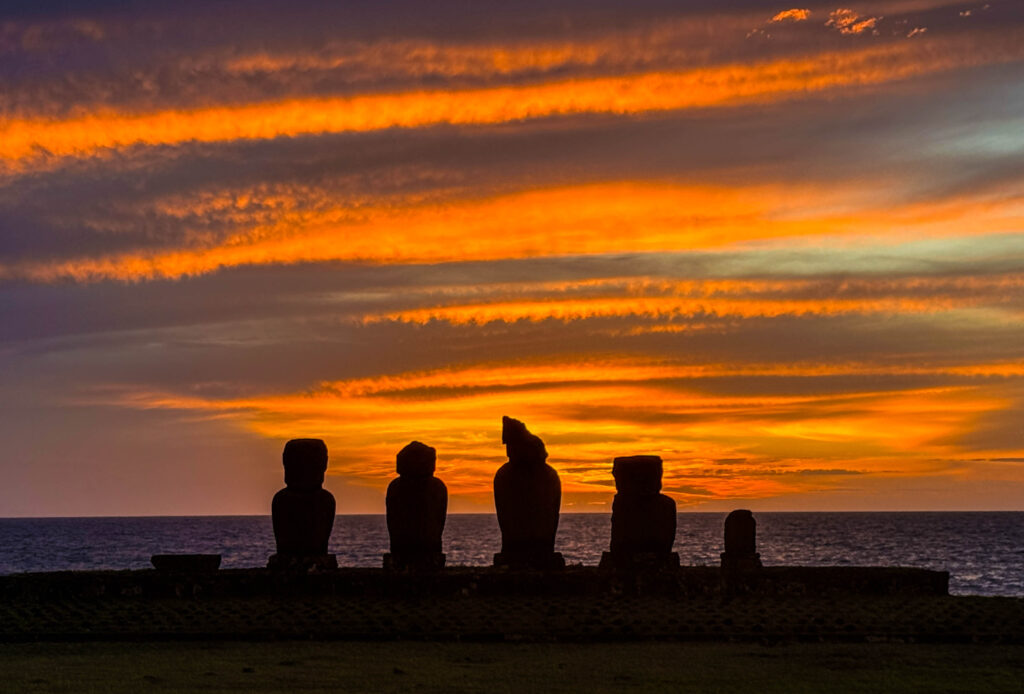
The moai are what draw most travelers to Rapa Nui, and it’s easy to see why. Towering and solemn, with elongated faces and oversized heads, they look like something out of another world. But they are not simply stone statues; they are embodiments of deified ancestors, carved to watch over their descendants and to project mana, or spiritual power.
Between A.D. 1250 and 1500, the Rapa Nui carved nearly a thousand moai from volcanic tuff at Rano Raraku quarry. Some stand over 30 feet tall and weigh more than 80 tons. There are almost 900 moai on the island, with more unearthed in recent years. They were transported across the island to stone platforms called ahu, which often served as tombs, containing the remains of the honored ancestor. In this way, the moai were both monuments and guardians, a bridge between the living and the dead.
The method by which these massive statues were moved has long fascinated outsiders. Early European accounts assumed that the Rapa Nui must have destroyed their forests by rolling statues on logs, thereby fueling the widespread “ecological collapse” theory. However, the Rapa Nui themselves have always claimed that the moai “walked.” In 2013, archaeologists showed how teams with ropes could “walk” a statue upright by rocking it forward step by step, just as oral tradition described. It wasn’t destruction, it was innovation.
The Faces of the Moai
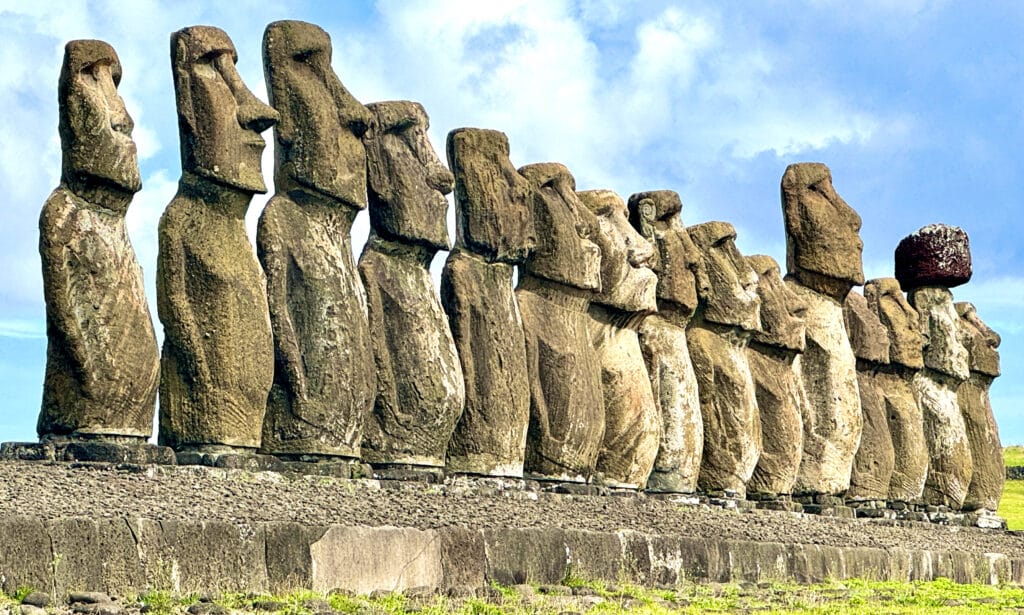
The moai’s iconic features, the elongated noses, heavy brows, and pursed lips, were likely symbolic, not literal portraits. Their eyes, once inlaid with white coral and red stone, would have given them a piercing, almost living gaze. Many also wore pukao, the red scoria “top knots” carved at Puna Pau, thought to symbolize hair or status headdresses. When the moai stood complete, they were not simply stone; they radiated power, presence, and connection.
By the 18th and 19th centuries, however, many moai were toppled during internal conflicts and later left fallen after European contact. Some remain face down, silent witnesses to upheaval. Today, restoration projects jointly led by Chilean authorities and Rapa Nui organizations have returned many to their ahu, where they continue to serve as watchful guardians.
The “Easter” in Easter Island
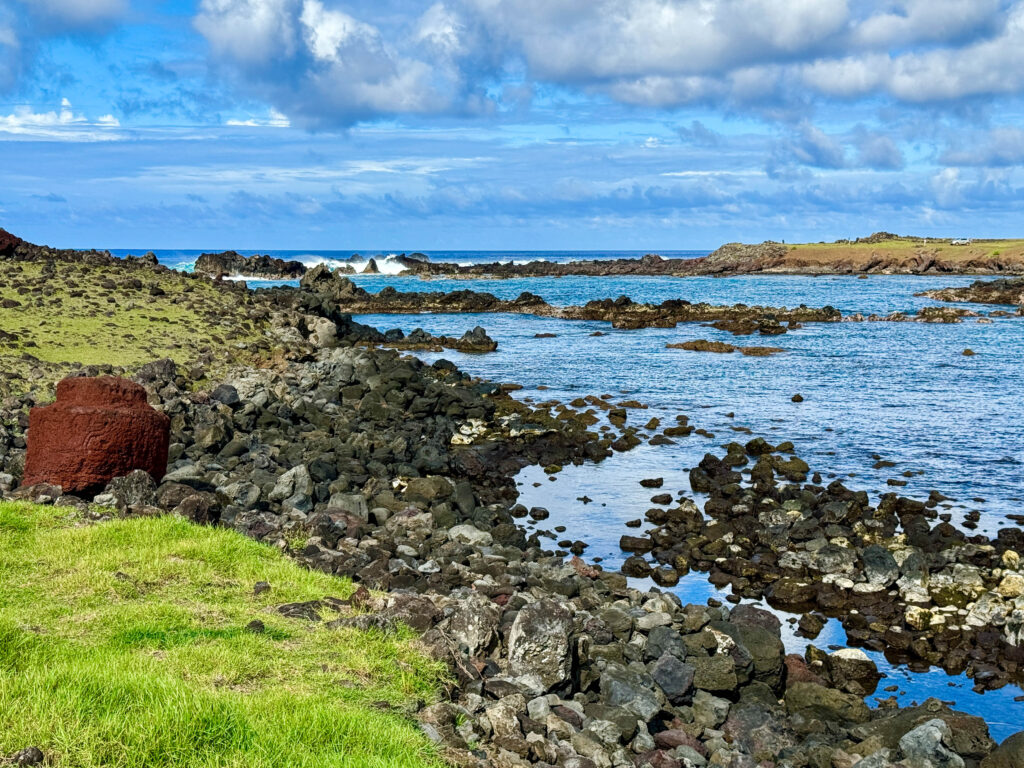
The name comes from Dutch explorer Jacob Roggeveen, who landed here on Easter Sunday in 1722. But the island always had a name, Rapa Nui, and a culture that nearly disappeared after the Europeans arrived.
In the 1860s, Peruvian slavers abducted over a thousand islanders, including chiefs and priests. Only a handful ever returned. Disease and colonial exploitation followed, and by the late 19th century, just around 100 Rapa Nui people remained.
Chile annexed the island in 1888, confining the Rapa Nui to Hanga Roa for decades. Only in the 20th century did they regain citizenship. Today, while Rapa Nui remains a Chilean territory, many sacred sites are co-managed by Rapa Nui organizations, part of the ongoing effort to reclaim autonomy and heritage.
Unmissable Sites: Where History Meets Horizon









1. Ahu Tahai – This site is a short walk from Hanga Roa and became our go-to place for sunsets. The moai here stand in silhouette against the sinking sun, and while the view is spectacular, what stayed with us was the atmosphere. Families gathered on the grass, dogs ran freely, and a quiet sense of community prevailed as the light faded and the ocean turned a golden hue. Our cabin faced Ahu Tahai, so the moai were always in our view; it was remarkable.
2. Rano Raraku Quarry – Standing in this “nursery” where moai were carved is like walking into a dream. Hundreds of statues lie frozen in different stages of completion, some buried to their shoulders, others lying on their sides as if abandoned mid-project. Each face seemed unique, and it was easy to imagine the carvers here, chiseling away centuries ago, the sound of wind and stone echoing through the air.
3. Anakena Beach – After days of rough volcanic landscapes, Anakena feels like a surprise. A stretch of white sand and palm trees, flanked by restored moai, it’s one of the only true sandy beaches on the island. We sat in the shade of palm trees, watching kids splash in the waves, and tried to picture what it must have been like when the first Polynesian settlers landed here centuries ago. The beach was packed with locals and visitors alike.
4. Tongariki – Seeing the fifteen moai lined up at Tongariki is overwhelming. They rise against the backdrop of crashing Pacific waves, and in the early-morning light, they glow in a soft pink hue that makes the whole scene feel sacred. It’s the image most people picture when they think of Easter Island, but being there in person is something words can barely capture.
The Birdman is Core to Easter Island History





5. Orongo & Rano Kau – Perched high on the cliffs above the ocean, Orongo was once the center of the Birdman ritual. From here, competitors would descend the cliffs, swim through rough seas to a small islet, and race to bring back the first sooty tern egg of the season. Standing above the cliffs plunging into the sea, it was easy to see why this place still feels charged with spiritual energy. Near the cliffs is the magnificent, vast crater lake of Rano Kau, which is the island’s primary source of freshwater. The view was breathtaking. You can visit the grounds where homes existed, and the petroglyphs that remain are fascinating.
6. Puna Pau – Scattered across the grassy hills of this quarry are the red scoria “top knots” or pukao, which once crowned the moai. They looked almost playful, like giant hats left behind. Walking among them, we tried to imagine how these enormous blocks of stone were transported and placed with such precision, and it gave us a new appreciation for the engineering skills of the Rapa Nui people.
Less-Visited Areas
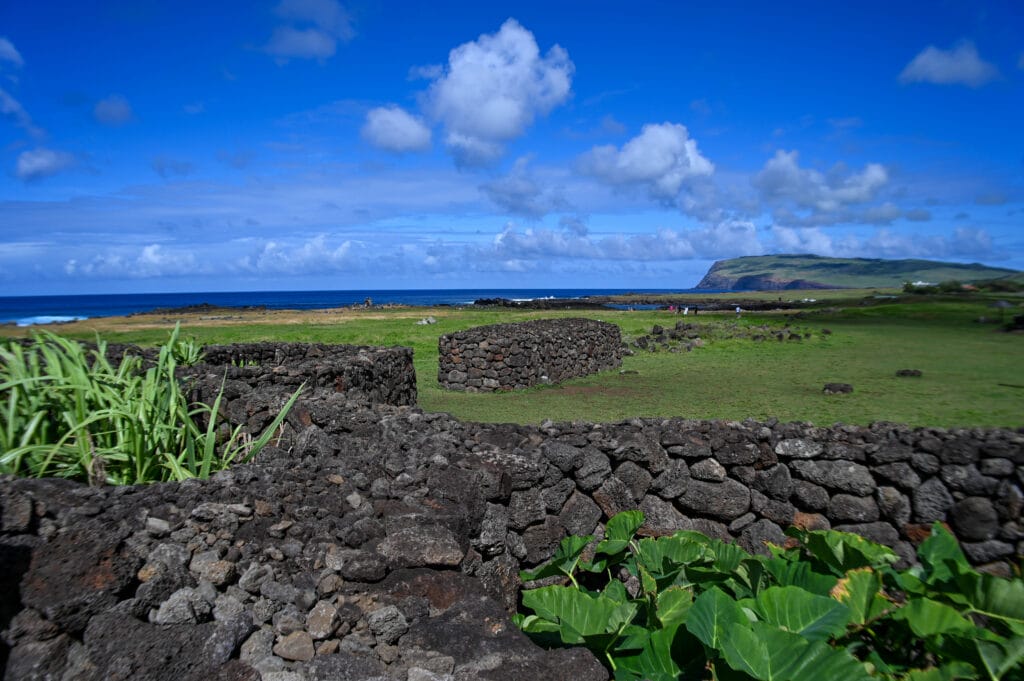
7. Ahu Akivi – What makes this site so special is its alignment. Seven moai stand inland, facing the ocean, something rare on Rapa Nui. The seven moai at Ahu Akivi are the exception. They face out toward the sea, perfectly aligned with the equinox, rather than inland. According to local tradition, they represent the seven young explorers sent by the Polynesian founding chief Hotu Matu’a to discover Rapa Nui before the main migration. Our guide offered another perspective: others believe the moai face the agricultural fields, suggesting they stand watch over the Rapa Nui people who labor there.
8. Te Pito Kura – Home to Paro, the largest moai ever moved, weighing in at 70 tons, this site radiates a sense of awe. Even toppled, the scale is hard to comprehend. Nearby is a large round stone locals call the “navel of the world,” said to hold spiritual energy.
9. Ahu Akahanga – Here, toppled moai lie scattered near the ocean, face down as if they fell in grief. The site is quiet, windswept, and raw. This was once believed to be the burial place of the island’s first king, Hotu Matu’a, and as one walked among the ruins, with the waves pounding nearby, it felt as though the past was still very close.
Rapa Nui National Park: Protecting a Living Heritage
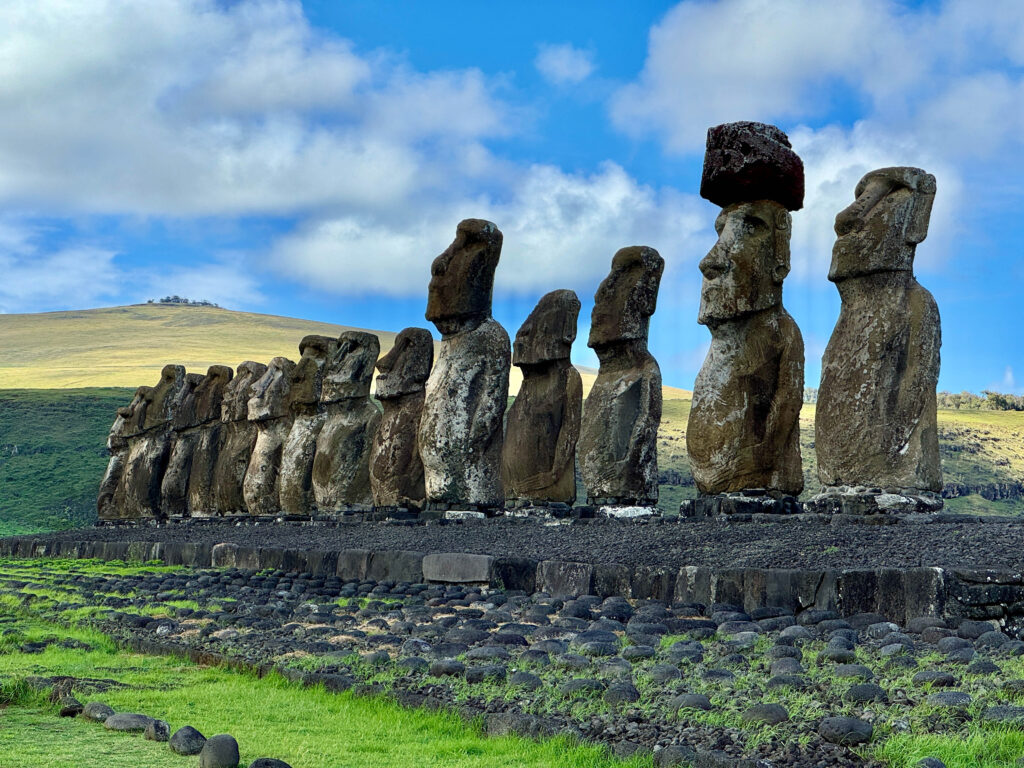
One thing that becomes clear the moment you step onto Easter Island is that this isn’t just a tourist destination, it’s a living heritage site. Nearly half the island is designated as Rapa Nui National Park, a UNESCO World Heritage Site that protects the moai, ancient ceremonial villages, quarries, caves, and sacred landscapes that make the island so extraordinary.
Park officials tightly regulate access across the island, and for good reason. To protect the fragile archaeological sites and honor the Rapa Nui people’s stewardship of their cultural treasures, visitors must explore most major sites with a licensed guide. And they mean it; try to enter without one, and you’ll be turned away. We saw it several times.
Officials instituted this requirement not just to control foot traffic but also to protect the island from damage caused by careless exploration. The moai, the ahu platforms, and the ancient rock art remain irreplaceable. Guides share the stories of the Rapa Nui people accurately, ensuring visitors leave with respect and lasting memories and photographs. Traveling with Roberto made the experience not only possible but unforgettable for us.
Entry to the park requires a pass, which should be purchased in advance before your trip. The process is straightforward and can be done online here. Having the ticket sorted ahead of time saves time and hassle upon arrival, and ensures you’re ready to start exploring right away.
So Much More to Offer than the Moai


















The statues draw you here, but it’s everything else that steals your heart. Most of the activities we booked were through Viator, which we have found reliable; communication has been excellent. Many of these activities, including our guide Roberto, can be booked directly.
People – Warm, welcoming, and proud to share their culture. Conversations with locals gave us a sense of great pride and resilience; every smile felt like an invitation into their world.
Ocean Life – Snorkeling, in crystal-clear waters, is like swimming in a giant aquarium. Schools of tropical fish surrounded us, and spotting a replica of a moai beneath the waves felt surreal. Our snorkeling trip was through award-winning Hahavera Rapa Nui, which also offers scuba diving (a hugely popular activity on the island) and other activities.
Horseback Rides – Riding to the summit of Mount Terevaka, the island’s highest point, gave us panoramic views of the endless ocean. On horseback, it felt like we were part of the landscape rather than just visitors. Our ride was through Adventure Terevaka Horseback.
Culture – Dance, music, and ceremonies, they were more than just staged productions; they were heartfelt and impactful. The energy of traditional songs and the rhythm of the dance connected us to something timeless. We thoroughly enjoyed our evening at the Te Ra’ai cultural event, which featured delicious local cuisine.
Brave enough to go to sea on a small fishing boat? Brandy was.
Fishing Trips – Brandy joined local fishermen, trolling the deep sea with hand lines. No technology, just stories, skill, and the sea. It was raw, honest, and unforgettable. She came back very excited from her excursion, and they caught some nice-sized fish that she brought back to our cabin.
Hiking & Caves – Trails led us to lava tubes and cliffside lookouts where we could imagine ancient Rapa Nui families seeking shelter. The landscapes were dramatic, windswept, and full of history.
Museum – The Father Sebastián Englert Anthropological Museum may be small, but it gave context to everything we saw on the island. Artifacts and explanations tied the stories told at the sites together. This is where we learned Rapa Nui is geographically part of Oceania, a fact that gave Ryan the thrill of adding another continent to his list.
Stargazing – With almost no light pollution, the sky came alive. Stargazing tours are a hit on the island, but sadly, the weather was not in our favor on the night we had free time. However, we heard fantastic things about these stargazing trips.
Sunsets – Let’s not forget the stunning sunsets that we had every night of our time on the island.
Those local creatures






Wildlife – Dogs and horses roam free, often joining you on walks as if they’ve always known you. Their presence gave the island a sense of freedom and companionship we didn’t expect. Not often in your life do you share a sidewalk with a free-roaming horse.
Dogs – They are everywhere and are so friendly. They seem well-fed and social. You will find the under tables at restaurants and walking with you to town. We came to love so many of them, and they truly enhanced the island’s charm.
A Taste of Rapa Nui: Food That Surprised Us










We didn’t expect Easter Island to be a foodie destination, but it turned out to be one of the trip’s best surprises. Everything we ate was fresh, flavorful, and lovingly prepared, making even the simplest meals feel special.
Ceviche is the island’s signature dish, and it quickly became our favorite. Made with just-caught tuna or mahi mahi, lime juice, onion, and just the right kick of spice, it was hands down the best ceviche we’ve ever had. It seemed like every restaurant had its own version, and somehow, each one topped the last.
When it comes to cocktails, the bartenders on Rapa Nui know their craft. Tropical blends of passionfruit, pineapple, and pisco arrived at our table as if they were works of art, often garnished with flowers or carved fruit. They tasted just as good as they looked, the perfect pairing with a sunset or a plate of fresh fish.
One afternoon, Roberto brought us to a local area where the islanders gather, Aloha Food Trucks. It was buzzing with energy, families sharing picnic tables, while music and the smell of incredible food drifted in the air. We ordered empanadas stuffed with fish and cheese, ceviche served in bright bowls, and skewers of perfectly grilled meat. What struck us most was that even in this casual setting, every plate was beautifully presented, as if the food itself was a point of pride.
Dining on Rapa Nui turned out to be an experience all its own, a reflection of the island’s creativity, generosity, and connection to the sea. For those who aspire to great coffee, there are lovely cafes, too.
How Much Does it Cost to Visit Easter Island?

We’d heard plenty about Easter Island’s reputation for being so remote that it must be very costly. We braced ourselves for high prices, but what we found instead was refreshingly reasonable. From where we stayed to what we ate and did, nothing felt overpriced. In fact, many things cost less than comparable experiences in a big tourist city.
Our cabin rental was modest and affordable; meals were consistently well-priced (even fresh ceviche and beautifully presented dinners), and activities like guided tours or car rentals felt fair given the access and depth they offered. Even the food trucks, one of our favorite experiences, came in at a fraction of the cost of casual meals in large tourist cities.
Yes, flights from the mainland can be expensive, but once you’re on Rapa Nui, the costs balance out quickly. In our case, we used our Alaska Airlines points, and it was free, and we were in business class, all for 40,000 points each.
We came prepared to splurge, only to discover that enjoying the island fully didn’t require overspending. For us, Easter Island was proof that remoteness doesn’t always mean unaffordable; it can actually feel like great value for what you get.
TIPS
When Is the Best Time to Visit Easter Island?
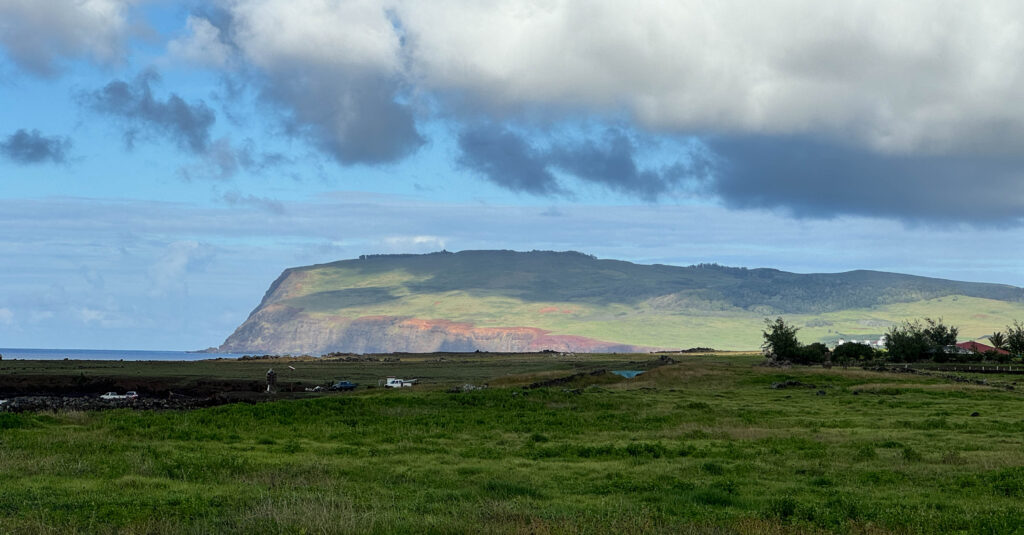
Easter Island can be visited year-round, but the experience shifts with the seasons. The island lies in the South Pacific, so its climate is subtropical and mild overall, though it varies with the season. That said, rain is common year-round; it comes quickly and leaves quickly, so be prepared. We weren’t a few times, just a few hundred from our cabin.
Summer (December to March) brings warm weather, long days, and lively festivals. Average temperatures hover around 80°F (27°C), making it the most popular time for travelers. January and February are the busiest months, coinciding with the Tapati Festival, when the island comes alive with music, dance, and traditional competitions.
Autumn (April to June) is quieter, with fewer crowds and slightly cooler temperatures in the mid-70s°F (24°C). This was when we visited, and it struck the perfect balance; beautiful weather for exploring sites and beaches, with a calmer atmosphere.
Winter (July to September) is the most incredible season, though it rarely dips below the mid-60s°F (18°C). Rainfall is a bit more frequent, but crowds are at their lowest. For travelers who prefer solitude and don’t mind a little wind and rain, it’s a rewarding time to visit.
Spring (October to November) sees the island slowly warming again. Flowers start blooming (they are beautiful), the air feels fresh, and crowds haven’t yet reached their peak. It’s a lovely time for hiking and outdoor exploration.
In short, there’s no wrong season for Rapa Nui, but if you want sunny skies and cultural energy, summer is the ideal time. For those seeking quieter sites and more affordable lodging, the shoulder seasons, such as April–June or October–November, may be the sweet spot.
Where to Stay on Easter Island
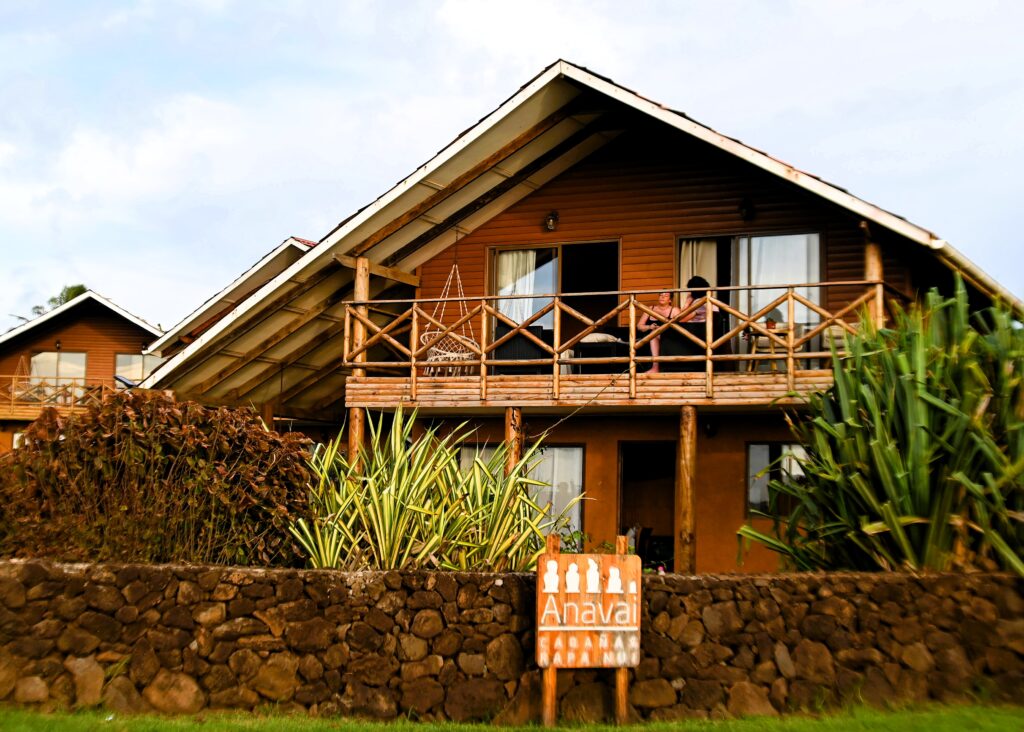
For such a small island, Rapa Nui offers a diverse range of accommodations, from cozy guesthouses and family-run cabins to boutique hotels with stunning ocean views. Most accommodations are centered in or around Hanga Roa, the island’s only town, which makes a convenient base with restaurants, shops, and the airport nearby. Options lean toward rustic charm rather than high luxury, but that’s part of the island’s appeal. You’re never far from the sound of waves, the sight of roaming horses, or a dazzling sunset.
We stayed at Cabaña Anavai, a simple three-bedroom cabin within walking distance of Hanga Roa, and it was perfect for our needs. With wood-paneled walls, basic furnishings, and no Wi-Fi, it felt humble yet homey. What made it special were the moments around it: wild horses passing by at all hours of the day, friendly dogs lounging on the porch, and sunsets that painted the sky behind distant moai. It was comfortable and affordable, and it gave us the sense of being part of the island’s rhythm rather than just visiting. For travelers, that’s precisely the kind of accommodation we recommend: authentic, welcoming, and close enough to the culture that you feel a little as if you belong. The property housed several cabins and a few rooms.
When planning a trip, it’s always wise to compare accommodation prices across different platforms. Expedia, based in the U.S., and Booking.com, based in Europe, don’t always feature the same properties, so checking both can give you the best range of options. We prefer Booking.com for its user-friendly interface and wide selection, but we always recommend double-checking the hotel or vacation rental’s official website. Sometimes, you’ll find exclusive deals or perks when booking directly.
Click the link below to explore hotels and vacation homes in the area you are planning to visit. Who knows? It might be just the spark you need to start planning your next grand adventure.
A Tip on Renting Cars
While rental cars are available on Easter Island, we wouldn’t recommend them unless you absolutely need one. Roads are rough in places, signage is not great, and prices are very steep and are all local. Most of the key sites are easily accessible with a guide, by taxi, or even on organized tours. Plus, walking or biking through Hanga Roa and beyond allows you to slow down and absorb the island’s rhythm without worrying about traffic. For us, skipping the car meant less stress and more time simply enjoying where we were. We did show her some visitors on Mopeds, but since most areas require a guide to enter, that could be of limited benefit.
Dengue Fever: What to Know Before You Go
Even paradise has some risks. Dengue fever exists on Rapa Nui, and while the risk is not extreme, it’s worth preparing for. The virus spreads through mosquito bites, especially during the warmer months and rainy periods. There’s no widely available vaccine for travelers, and no specific treatment, so prevention is key.
Pack and use mosquito repellent containing DEET or picaridin. Wear lightweight, long-sleeved clothing and pants when possible. We strongly advise you to bring repellent. We brought a small amount but ran out. The only place to buy more is at the pharmacy, and it was closed when we tried to get more. Consider sleeping under a mosquito net if your accommodations don’t have well-screened windows, though we didn’t feel the need to do so. Most importantly, stay alert to symptoms such as sudden fever, headache, or joint pain, and seek medical care promptly if they appear.
Final Reflections: A Place That Lingers
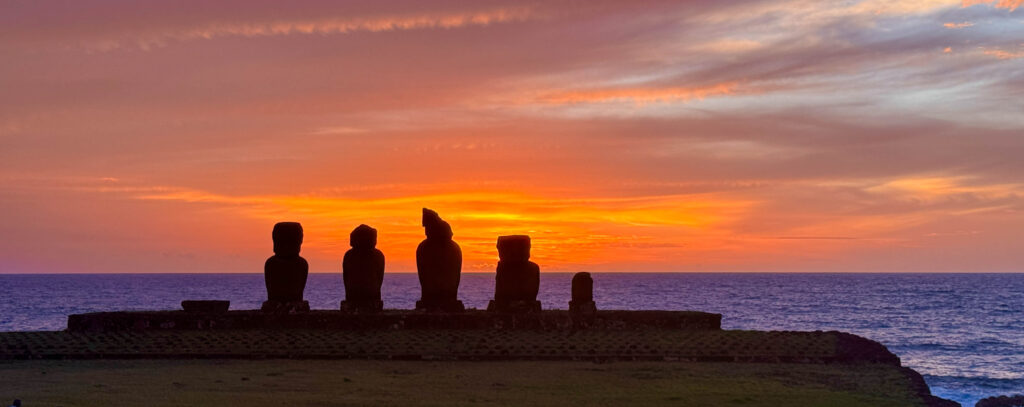
Rapa Nui is not just beautiful, it’s profound. Its history is painful, but its survival is inspiring. Its landscapes are rugged, but its spirit is alive.
We came chasing the mystery of the moai. We left with something more profound: a connection to a culture that endures against impossible odds, a reminder from Brandy to embrace the moment, and a longing to return.
Five nights gave us a taste. Next time, we’ll stay longer.
Want to read more?
Check out our feature for FWT Magazine:
8 Things to Love About Easter Island Beyond the Moai
© 2026 Wanderers Compass All Rights Reserved
Disclosures/Transparency: Our visit to Easter Island/Rapa Nui was entirely on our own expense. We had no special access, activities, discounts, or services that any other visitor would experience.
To learn more about Easter Island/Rapa Nui, check out their official tourism website.
Easter Island/Rapa Nui Photo Gallery






























Want to learn about Wanderers Compass?
Check out our most recent posts
Our Top Recommended Travel Products
Travel Insurance
Squaremouth.com
Our favorite travel insurance site!
We strongly advocate comprehensive travel insurance, not only for minor inconveniences but also for major, unexpected events such as medical emergencies. We never leave home without it. Our go-to resource is Squaremouth.com. which offers a user-friendly platform that connects you with top-rated, reputable insurance carriers. Plus, they’ll mediate on your behalf if you run into any issues.
To empower you as a consumer, we recommend you read our blog post on why travel insurance is essential and how to secure the best coverage from leading companies at an affordable price.
MedjetAssist
Medical transport back home from anywhere in the world
Medjet is a leading provider of global air medical transport. Unlike traditional travel insurance, which typically covers medical evacuation to the nearest facility, Medjet goes further by ensuring you’re transported back to the U.S. to the hospital of your choice once you’re stable enough to fly. Medjet offers membership plans that focus on medical transport, while Medjet Horizon provides expanded coverage for broader protection. Individual trip policies start at just $99, and annual policies are available for around $300. Most policies have an age limit of 74.
To learn more about how Medical Evacuation membership with Medjet Assist works, check out our blog post for a more detailed review.
Accommodations and Airfare
Booking.com
Hotels, Home rentals, BNBs, Flights, and other Transportation & Tours
Booking.com connects millions of travelers to unforgettable experiences, a wide range of transportation options, and incredible places to stay—from homes to hotels and beyond. As one of the world’s largest travel marketplaces, it supports well-known brands and entrepreneurs of all sizes. For its convenience, variety, and reliability, it’s our preferred booking platform.
Expedia and VRBO
Hotels, home rentals, BNBs, flights, and other transportation & tours
Expedia is a U.S.-based company with a mission to make global travel accessible to everyone, everywhere. At Wanderers Compass, we embrace independent travel, and platforms like Expedia are essential to making that a reality. Expedia allows you to book every aspect of your trip—from flights and accommodations to rental cars, cruises, and activities—making it a one-stop shop for all your travel needs.
Transportation
Daytrip
Personalized city-to-city private car transfer service
Daytrip provides an affordable private car service for city-to-city transfers worldwide, and we absolutely love their service. It’s a cost-effective alternative to renting a car, offering comfortable, stress-free travel with the added benefit of scenic stops along the way. For example, we used Daytrip for travel between Budapest and Vienna, enjoying some fantastic detours to local attractions. With professional drivers and customizable routes, Daytrip ensures a smooth ride while allowing you to explore hidden gems and unique sights along your journey.
To learn more about Daytrip, check out our blog post for a more detailed review.
Travel Experiences
Viator
The leading marketplace for travel experiences
Viator believes that travel is all about creating unforgettable memories. With over 300,000 experiences to choose from—ranging from simple tours to extreme adventures, plus a wide array of unique, niche activities—it’s never been easier to make lasting memories. We frequently use Viator during our travels and especially appreciate its flexible cancellation policy, which provides peace of mind with every booking.
Communication products for seamless connectivity overseas
GigSky International eSIM Data Plans
Local Prices. No Roaming. Fastest Networks.
GigSky eSIM effortlessly connects travelers worldwide, eliminating the need to swap physical SIM cards or face unexpected roaming charges. With affordable data plans and instant activation, you can enjoy reliable internet access in over 190 countries, making your travel experience more convenient than ever. Plus, they offer a fantastic deal: a free 100 MB data plan with no credit card required. They are so confident that you will love their service!
Enjoy 10% off all GigSky Plans (except cruise and inflight) with our discount code WCOMPASS10.
To learn more about how GigSky works, check out our blog post for a more detailed review.
Shopping
Wanderers Compass Amazon Storefront
An excellent source for all travel essentials and guides that we have vetted ourselves
Amazon is one of the world’s most comprehensive online shopping platforms, offering lower prices, a wide selection, and fast delivery through its global fulfillment network.
This page contains affiliate links. When you purchase through these links, we may earn a small commission at no extra cost to you. Thank you for your ongoing support!

